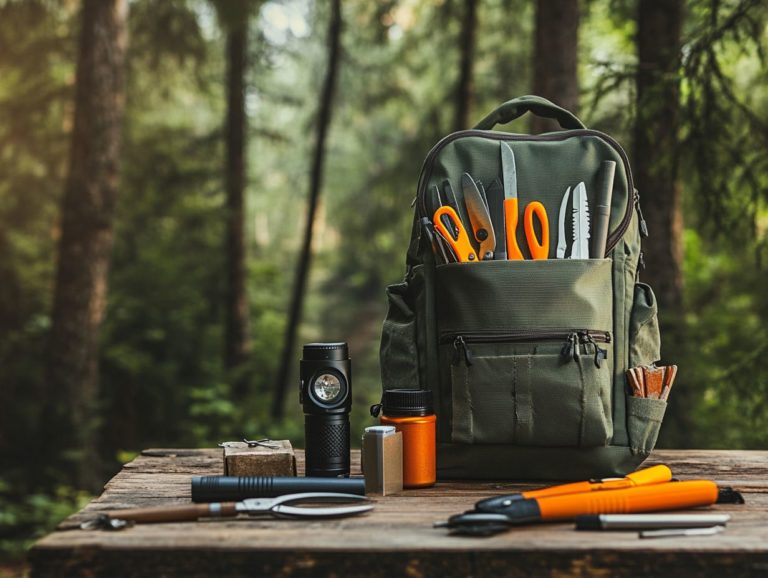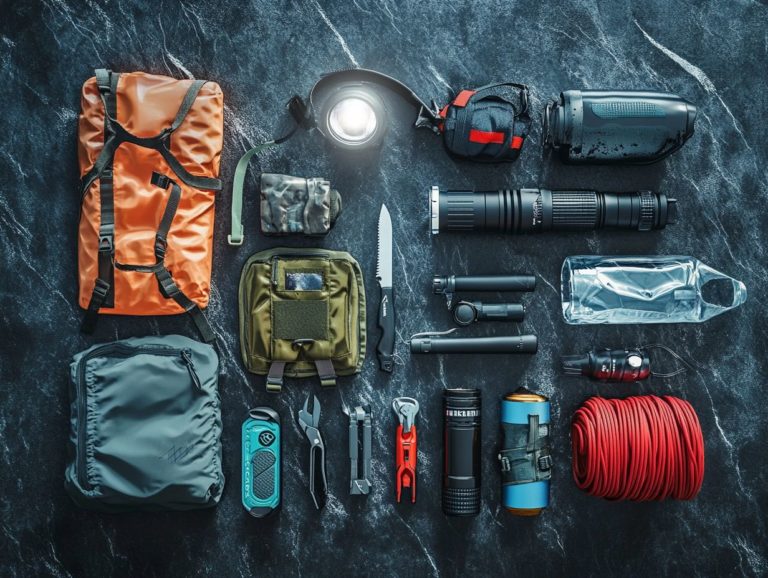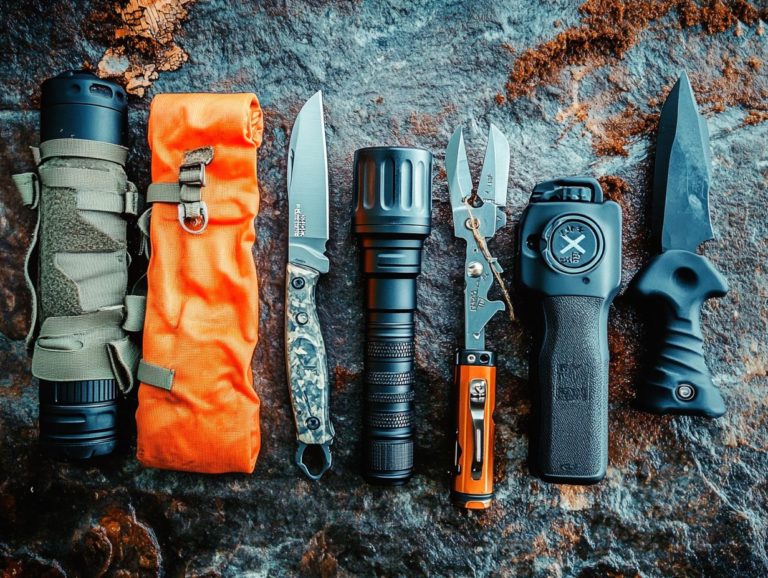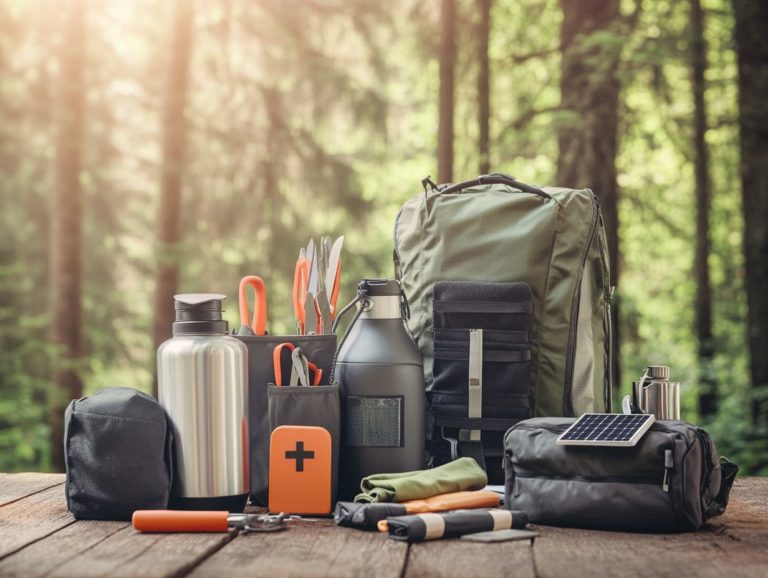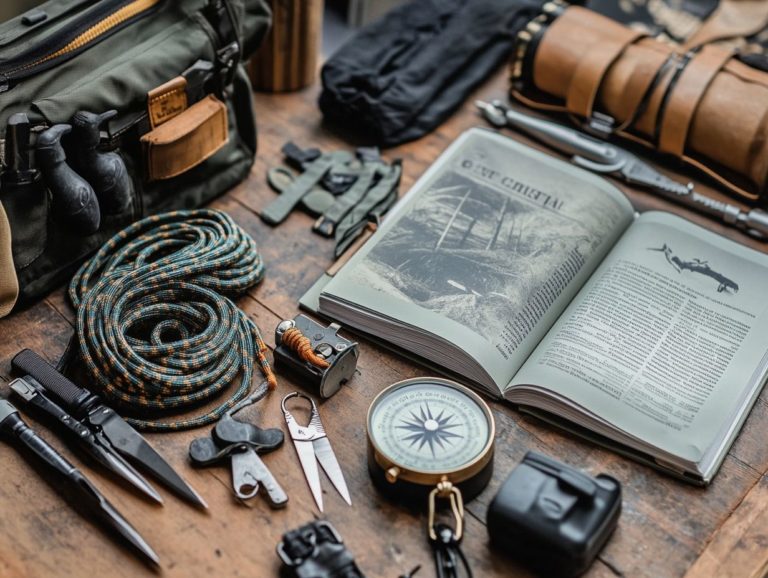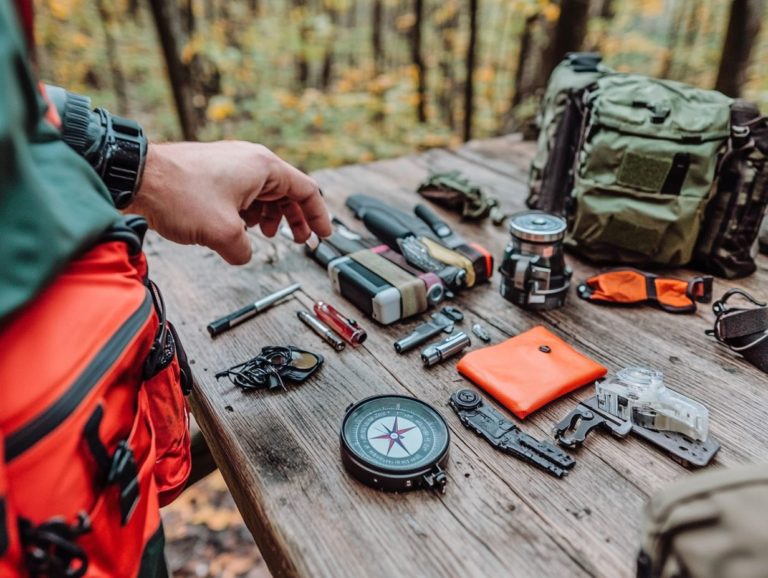How to Use Survival Gear in Dark Conditions
Navigating the darkness can feel intimidating, whether you re camping beneath a starry sky or dealing with an unexpected power outage.
Having the right gear is crucial for your safety and efficiency in low-light scenarios. This article delves into essential equipment, including basic tools like flashlights and headlamps, as well as advanced technologies like thermal imaging devices.
You ll discover tips for using your gear effectively and the must-have items to pack for any after-dark adventure. Arm yourself with the knowledge you need to face the night with confidence!
Contents
Key Takeaways:
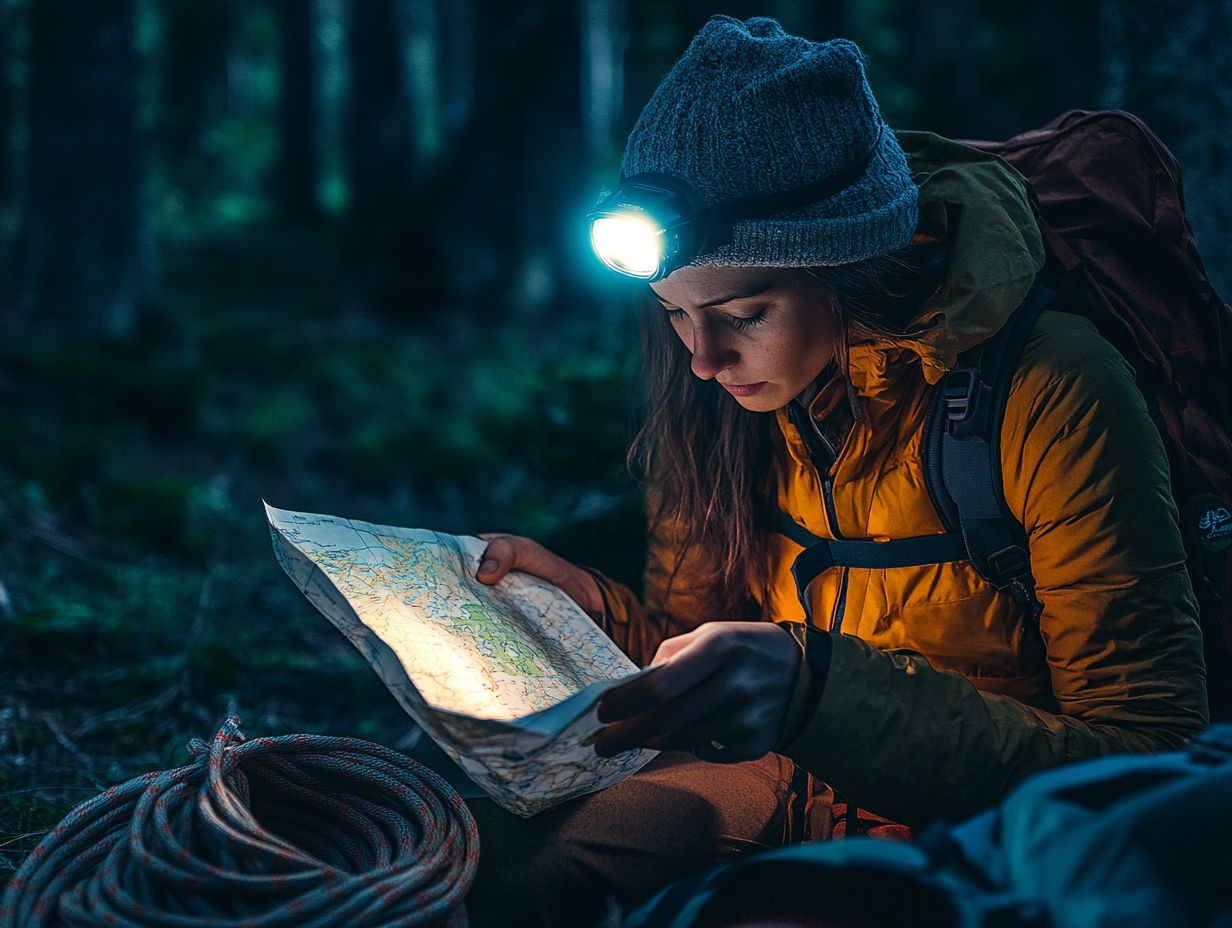
- Pack the right gear for dark conditions; it can save your life.
- Get essential items like flashlights and headlamps to keep you safe in the dark.
- Train with your gear so you know how to use it effectively when it matters most.
Why Proper Gear is Essential
In the realm of wilderness survival, having the right gear is crucial for your safety and success in the wild. Proper gear includes crucial items like survival kits, first-aid kits, and personal survival equipment, which can mean the difference between life and death in emergencies.
From emergency packs that contain important survival items to outdoor navigation tools that help you find your way, understanding the importance of each component enables you to prioritize what to carry.
Investing in the right equipment significantly boosts your preparedness for any situation that may arise.
Basic Gear for Dark Conditions
When you venture into the wilderness, especially under the cover of darkness, having fundamental gear like flashlights and headlamps becomes crucial for both visibility and safety. These essential tools not only light your way but also help you navigate effectively.
Beyond lighting, packing an emergency bivvy, a small, portable shelter that keeps you warm, offers a lifeline of shelter and warmth. The right outdoor gear and backpack essentials prepare you for any unexpected nightfall or challenging conditions.
By understanding and gathering this basic gear, you can elevate your peace of mind and enrich your wilderness survival experience.
Flashlights and Headlamps
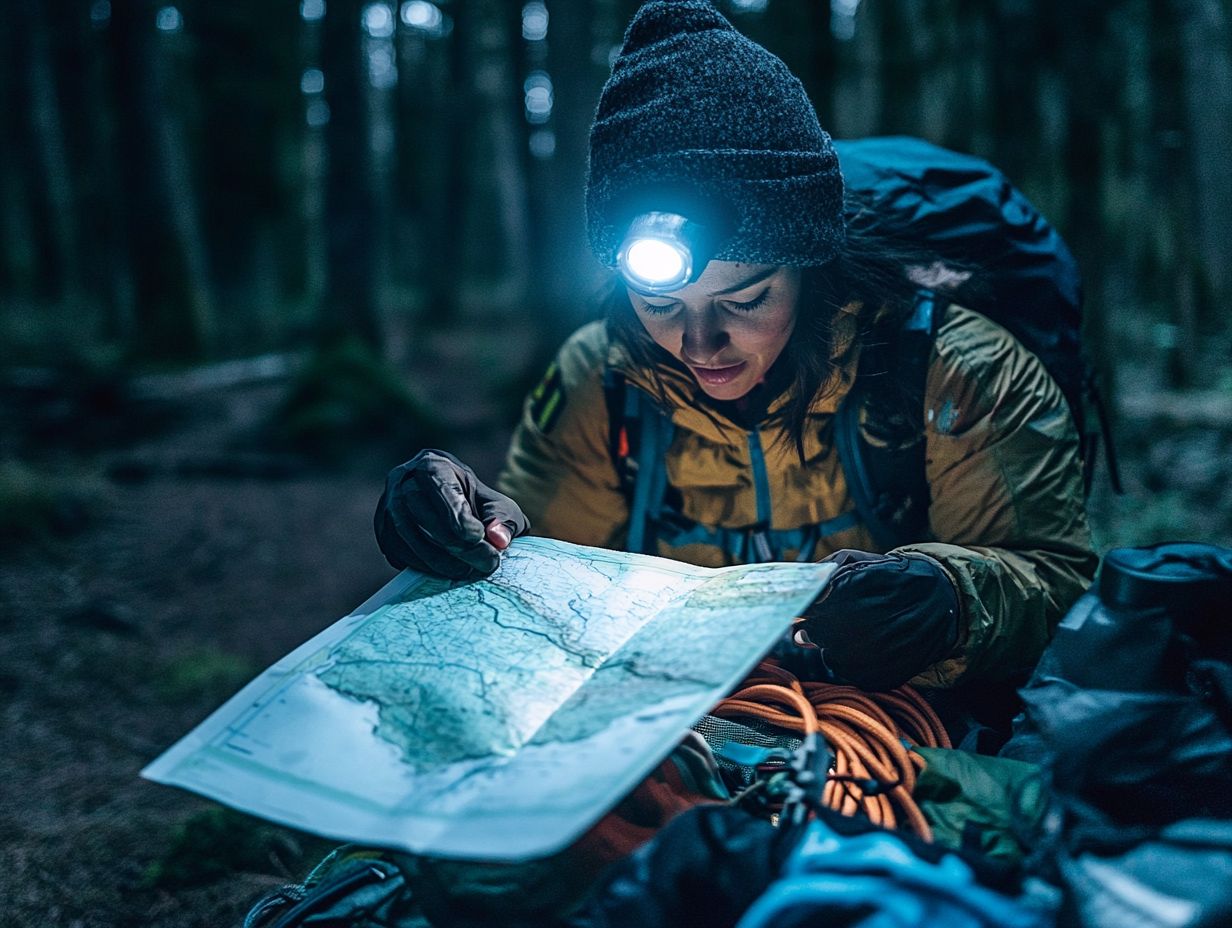
Flashlights and headlamps are essential companions for anyone looking into outdoor navigation under the cloak of darkness. They offer vital illumination that guides you toward safety.
With a range of styles and brightness levels available, they provide the versatility needed for various situations. Imagine traversing a rugged trail after sunset or setting up camp in fading light; having the right equipment can truly transform your experience.
Flashlights typically deliver focused beams perfect for illuminating distant objects, while headlamps shine in providing diffuse light, giving you a wider view ideal when you’re trying to read a map or pitch a tent.
Many models come equipped with adjustable brightness modes and energy-saving settings, making them smart choices for extended adventures. In wilderness survival scenarios, incorporating these light sources into your gear not only aids in navigation but also enhances your safety by making it easier to signal for help when necessary.
Night Vision Devices
Night vision devices significantly enhance your ability to navigate and observe your surroundings in the dark, giving you an advantage in wilderness survival situations. These advanced tools elevate visibility beyond what mere flashlights can provide. You can detect movement and obstacles that would otherwise remain hidden.
By integrating night vision devices into your outdoor gear, you can move stealthily and make informed decisions during nighttime expeditions. This ultimately improves your safety.
Among the various types of night vision devices, you will find monoculars, binoculars, and even goggles. Each is tailored for specific uses such as tracking wildlife, navigating tricky terrains, or bolstering security during camping trips. Unlike traditional lighting methods, these devices amplify ambient light while offering a clearer image without the blinding glare. They are essential for activities like hunting or stargazing.
It s essential to consider safety aspects, as improper use can lead to disorientation or accidents. Therefore, understanding the features and proper handling of night vision technology is crucial for maximizing its benefits while minimizing risks in the great outdoors.
Advanced Gear for Dark Conditions
As you immerse yourself in the world of wilderness survival, equipping yourself with advanced gear like thermal imaging devices and infrared illuminators becomes essential for navigating safely in low-light conditions.
These sophisticated tools enhance your visibility by detecting heat signatures, giving you a significant edge in locating wildlife or other individuals. When seamlessly integrated into your overall survival kit, these cutting-edge technologies can revolutionize your outdoor navigation. This makes your nighttime expeditions not just more efficient but also far more informed.
Thermal Imaging Devices

Thermal imaging devices greatly improve your visibility in the dark. They help you spot living beings and navigate difficult terrains, even when it s pitch black.
Integrating thermal imaging into your survival gear can profoundly enhance your outdoor navigation and situational awareness. This equips you to make well-informed decisions while on the move.
These devices function by converting thermal energy into visible images. They reveal temperature differences between objects and their surroundings. In practical situations like tracking wildlife during a night trek or locating a lost companion these features offer distinct advantages.
Thermal imaging helps you identify potential hazards, such as campfires or other heat sources. This ensures your safety during nighttime excursions.
The benefits extend well beyond visibility; thermal imaging sharpens your decision-making efficiency. It enables you to assess your environment quickly and accurately. From search-and-rescue missions to routine camping trips, its applications are essential for anyone daring enough to venture into the wilderness.
Infrared Illuminators
Infrared illuminators boost visibility in low light. They work with night vision goggles, allowing you to move quietly at night without drawing unwanted attention.
When integrated into your outdoor gear, infrared illuminators elevate your survival techniques. They enable effective navigation and heightened situational awareness in the dark.
Their utility goes beyond simple illumination; they can significantly boost the effectiveness of thermal imaging cameras, which detect the heat emitted by objects. This synergy allows for a more comprehensive assessment of your surroundings, whether you’re tracking wildlife or identifying potential threats.
In various survival scenarios, the advantages of using these illuminators become quite apparent. Whether you’re setting up camp at dusk or scouting for resources, their presence ensures you remain stealthy yet well-informed. This combination of advanced night vision capabilities and long-range detection is essential for outdoor enthusiasts like yourself who prioritize safety and efficiency in their survival strategies.
Be prepared for anything the night throws at you with these essential tools!
Using Survival Gear in Dark Conditions
Effectively utilizing survival gear in low-light conditions demands a thorough understanding of the tools at your disposal, as well as practical tips and techniques to fully harness their potential for safety and navigation.
Implementing strategies like ensuring fire safety and mastering signaling techniques can greatly boost your chances of survival.
A comprehensive grasp of your gear enables you to act with efficiency and preparedness, particularly when darkness descends.
Tips and Techniques for Optimal Use
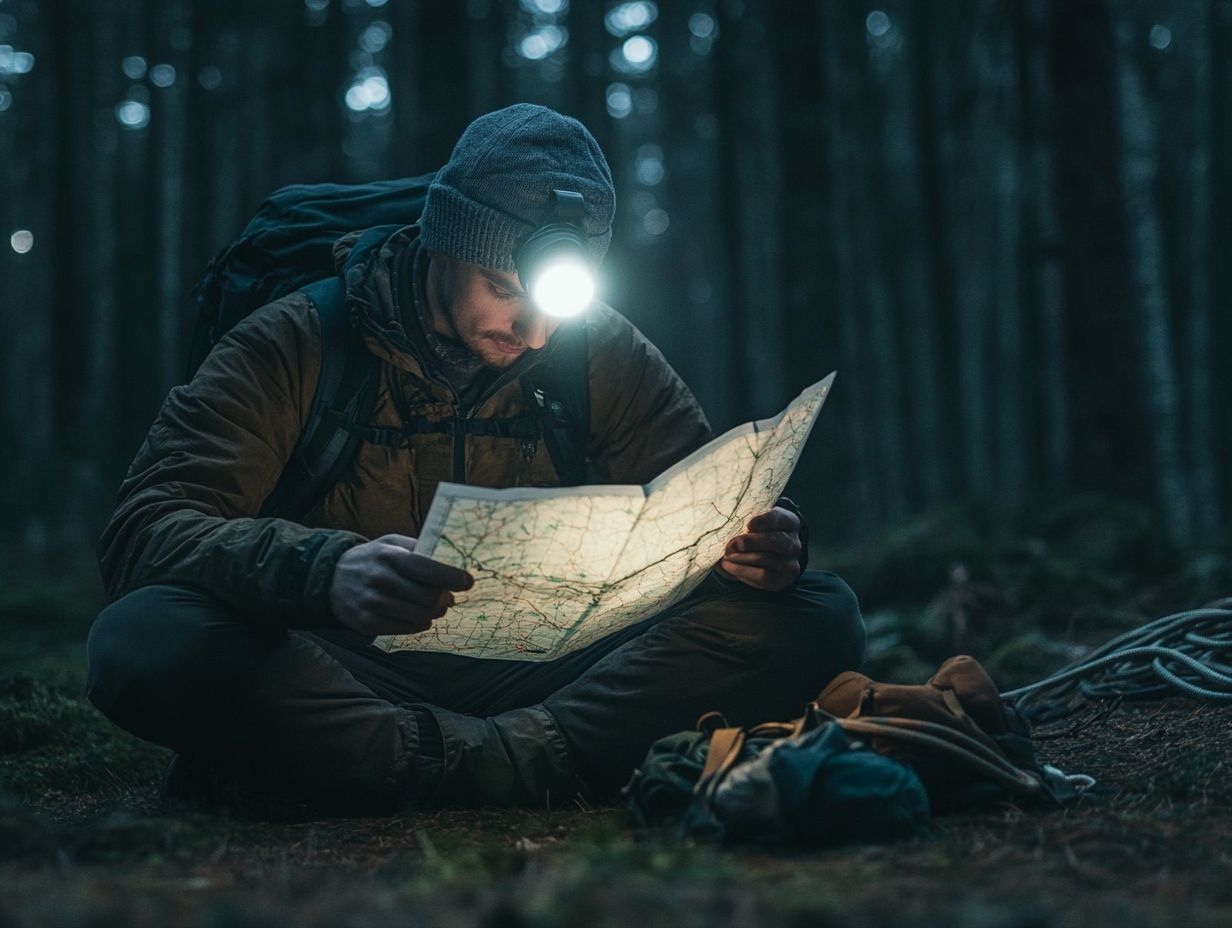
To ensure you’re making the most of your survival gear, implementing specific tips and techniques can significantly enhance your effectiveness in dark conditions. Strategies such as practicing proper outdoor navigation and getting well-acquainted with your emergency pack will elevate your preparedness. This will boost your confidence when faced with unexpected challenges.
Understanding the capabilities and limitations of your gear allows you to make informed decisions out in the wilderness. To enhance your experience even further, consider organizing your emergency pack with items that are easily accessible and clearly labeled, like a signal mirror. This thoughtful arrangement can save you precious time during a crisis.
Regularly practicing your navigation skills, including compass use with a map, is essential. Also, ensure you have a reliable knife blade since depending solely on electronic devices can lead to complications when the battery unexpectedly dies.
Take the time to conduct mock drills, including fire-making exercises, simulating various scenarios to test your response in low-light situations. Familiarity with each item in your kit like multi-tools and flashlights will enable you to use them effectively when it matters most, ultimately increasing your chances of successful navigation and survival.
Preparing for Dark Conditions
Preparing for dark conditions and survival priorities in the wilderness requires careful planning and the thoughtful selection of essential items to ensure your safety and survival. This includes carrying a survival knife. It s imperative that you familiarize yourself with your backpack gear, ensuring you have immediate access to critical items like a reliable flashlight, a water bottle, an emergency bivvy, and a complete first-aid kit, which should include cutting cordage and medical gear.
Proactive training sharpens your skills and enhances your ability to utilize these tools effectively. This boosts your confidence through mastering techniques like shelter building and being ready for any unexpected scenarios that may arise.
Essential Items to Pack
When preparing for dark conditions, keeping your fire starter handy and packing essential items is crucial for ensuring your survival and comfort. Consider equipping yourself with a well-stocked survival kit featuring water purification tablets, a water purification system, emergency food, dry tinder for cooking, and a compact fire starter.
Having your backpack essentials, such as cordage, readily accessible will enable you to respond effectively to any situation that arises when visibility is compromised. Each of these essentials plays a pivotal role in maintaining your safety and preparedness.
A quality headlamp or flashlight, complemented by a compact fire starter, not only illuminates your path but also signals your location. Extra batteries for your lanterns can prove invaluable during extended periods of darkness. Additionally, a whistle and signal devices for emergencies serve as straightforward distress signals. For more detailed instructions on using these items effectively, check out how to use survival gear in emergency situations, making it easier for rescue teams to locate you.
Layering your clothing for warmth is critical, as temperatures can drop significantly after sunset. Packing a first-aid kit ensures that you can manage injuries promptly, enhancing your chances of survival in unforeseen situations. Remember, a map and compass can guide you when technology may fail, underscoring the importance of traditional navigational tools.
Training and Familiarization
Training with your gear is essential for effective survival. It includes maintaining the right mix of salts and minerals in your body, especially in low-light conditions.
Engaging in practice sessions helps you learn how to operate each piece of equipment. This also sharpens your essential outdoor navigation skills, ensuring you can find your way in complete darkness.
This preparation includes mastering the use of compasses, water storage items, and maps. These tools can help you plan your purifying methods and understand various types of survival gear like lanterns, first aid kits, and emergency whistles.
Practicing these skills in real-world scenarios enhances your ability to navigate challenging terrains. You ll also manage unexpected obstacles more effectively.
Emergency response techniques are vital. Building a shelter, using plastic sheeting, and signaling for help with a magnesium block will become second nature with practice.
This training equips you with both knowledge and mental resilience. You ll be prepared to thrive in the wilderness, greatly increasing your chances of survival!

